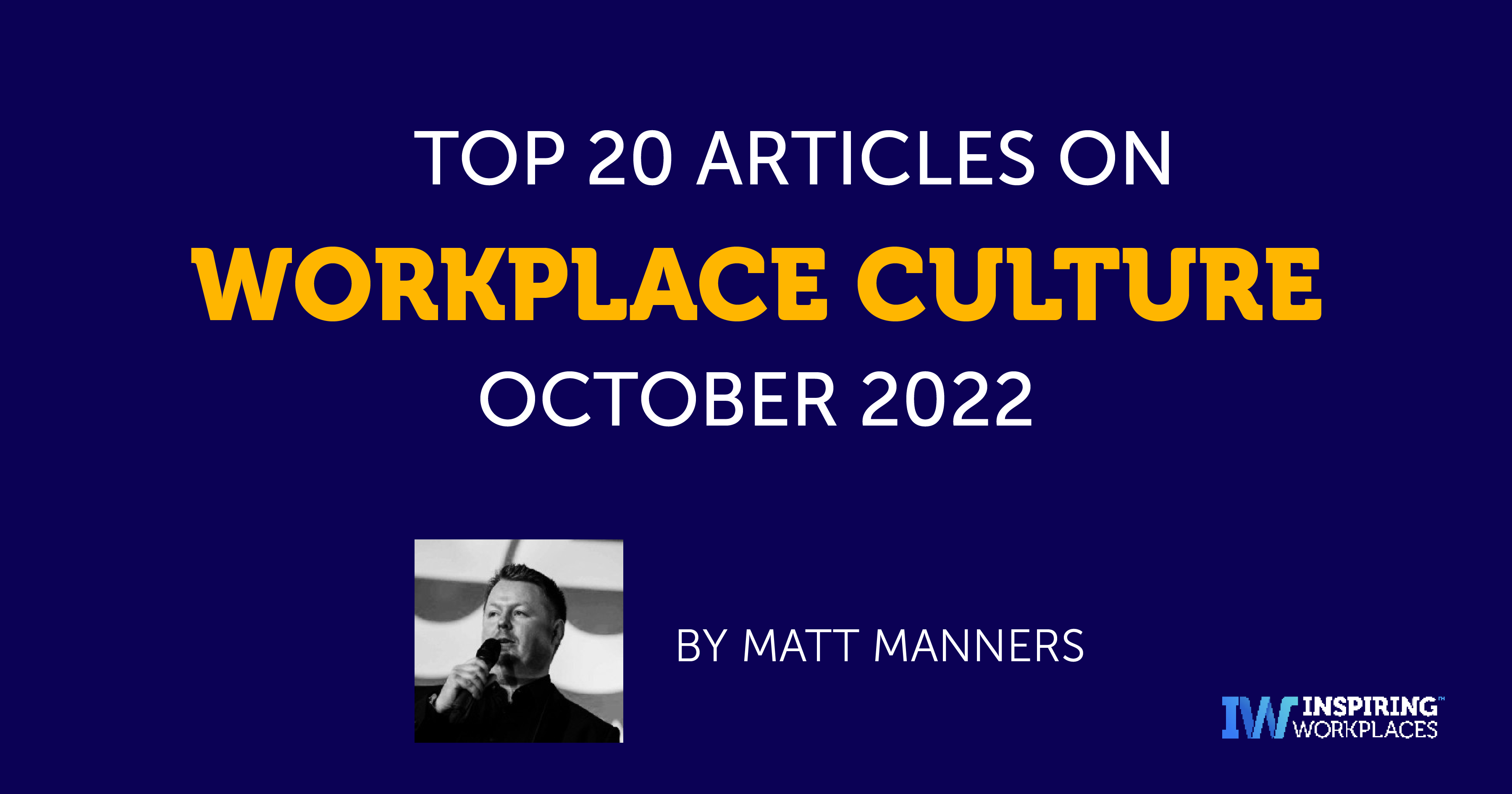
31st October 2022
Top 20 Articles on Workplace Culture for October 2022

Welcome to the Inspiring Workplaces Top 20 Articles on Workplace Culture for October 2022.
We want to help inform and inspire you from some of the best content out there. Each month we will consolidate these articles for you to help give you a quick and easy snapshot. To help drive you and your organisations forward.
The articles will be underpinned by six key elements that are reflected in our awards. They are:
- Wellbeing
- Culture
- Leadership
- Inclusion
- Employee Engagement
- Communication
How To Promote Wellness In The Workplace
Takeaways:
- It’s a known fact that happy, healthy employees are more productive; as a result, businesses are looking for new ways to engage and motivate their team through workplace wellness initiatives.
- But for many businesses, the problem is knowing where to start. With so many different workplace wellbeing programs, ideas and strategies out there, companies are at risk of wasting valuable time, money and resources on wellness initiatives that simply don’t work.
- Work wellbeing activities include various aspects of work culture, such as physical, mental and social well-being. They are designed to have positive outcomes like decreasing absenteeism, increasing collaboration, sparking creativity, boosting productivity, and encouraging employee relations.
- Mental well-being is vital for employee wellness and work happiness. Mental wellness initiatives at work can help to improve both brand reputation and staff loyalty.
- There are a number of things that employers can do to show their interest in mental wellness at work; including free or discounted therapy sessions, and mindfulness or meditation classes.
- Exercise is a great way for employees to relieve stress; and something that every business should offer in their workplace wellness plan. Whether it’s organising a team for 5-a-side football or arranging classes in the office such as yoga or pilates, encouraging staff to partake in physical activity at work is a great way to improve mental wellness at work.
- Healthy eating can play a huge role in ensuring employee workplace wellness. A quick win for business of all shapes and sizes, having healthy snacks in the office has been proven to help improve concentration – not to mention that healthy employees are more productive!
- Work environment is one of the most important things when it comes to workplace wellness. A healthy workplace environment – one that includes lots of light, working tech, and comfortable seats and desks – can help to reduce absenteeism and boost productivity.
- Emotional wellness at work is often underestimated, and social events can really help to improve employee relations and engagement.
- Employees love the option to work flexibly, and it has been proven to have a positive effect on workplace wellness
- In order for health and wellness ideas in the workplace to be effective, they need to be led and championed by management. Collectively, managers and team leaders need to help create a company culture where employee wellness is a priority; by encouraging their team to look after their mental health and wellbeing activities at work.
By: Editorial Team
Source: Work Life
Read the full article here.
Four Ways To Address Communication Problems In The Workplace

Takeaways:
- Workplace communication is one of the most popular topics of the day. The shift to hybrid in-office/at-home work has been swift and has changed the way we work and communicate.
- A recent survey shows that 39% of employees believe there is a lack of collaboration and communication in their companies.
- The first step in fixing any problem is acknowledging it exists. When there’s a derailment of any kind, it will never sort itself out. It’s far better to recognize it and take action.
- One of the major mistakes when it comes to communication training happens when companies go about it negatively. When an obvious communication problem is causing decreased engagement and poor results, they may immediately jump in with a long list of behaviors to change.
- Learning, however, should be built around positive examples instead of focusing on what not to do.
- Employee feedback should be constant and worked into all the organizational processes. It’s the only way to mitigate problems as soon as they arise. Whether you opt for anonymous feedback or personal conversations, it’s crucial that employees feel comfortable speaking their minds and pointing out any negative aspects of their work.
- A recent study of more than 36,000 employees showed that managers whose overall skills are rated higher in areas such as psychological safety lead teams that bring in an average of $4.3 million more in annual revenue. The study also highlighted the link between psychological safety and effective communication.
- One of the most significant challenges of the hybrid workforce is avoiding working in silos. To do this, updating your communication strategy to ensure the effective distribution of timely news and important updates is critical.
- Company culture is the starting point in setting the parameters for employee collaboration. When communication issues arise, they need to be identified and addressed swiftly. The right tools, processes and leadership are paramount in ensuring open and constructive workplace communication.
By: Graham Glass
Source: Forbes
Read the full article here.
3 Steps to Start Your DEI Initiative
Takeaways:
- When I asked my audience of over fifty thousand people what they find challenging about DEI, the number one answer is: I am afraid of making a mistake or saying the wrong thing.
- Cancel culture has scared the shit out of people. Why? Because one wrong statement can cost you your livelihood, and even the best-intentioned have messed up.
- And it isn’t helping. It’s punitive, and I get why that feels good, but it leaves no space for learning. And without learning there can be no progress. Period.
- We have to stop looking at DEI as a destination and acknowledge it for what it is: a skill.
- Think back to when you learned something new. It can be anything basketball, chess, or singing. You pick. It was really hard at first, right? But you practiced again and again, and now you don’t even have to think about what you’re doing. Now, when you do your thing, it feels easy—almost automatic. Inclusion and belonging work the same way. So when you practice DEI skills, and you practice them enough, they become automatic.
- Often times our brains have created unhelpful thinking habits that cause us to prejudge others without being aware of it. This is called unconscious bias, and it must be counteracted by building DEI skills.
- The biggest mistake I see companies make when starting their DEI journey is that they leave out the thoughts, feelings, and experiences of the people they are trying to reach.
- You might think that racism is the most pressing issue but learn from employees that ageism is just as prevalent. When you include employees in your DEI strategy, it feels less like you are forcing them, and more like you are concerned about their experiences.
- The next time you’re with friends, and they say something out of line about a diverse group, ask them to explain what they mean by their statements. Alternatively, if you want to build your skills communicating with diverse people, start with someone that knows you well, and be honest about your intention to grow in areas where you need to.
- After you prioritize DEI skills and practice them for a while, you’ll plateau and may even start to backslide towards where you started – assumptions. So keep in mind that there is always something new to learn, be compassionate with yourself, and give grace to others who are learning.
By: Risha Grant
Source: LinkedIn
Read the full article here.
What Drives Happiness (and Performance) at Work?
Takeaways:
- The single greatest driver of happiness and performance in the workplace is the quality of your relationships.
- The majority of things we hate most about work are also relational – and entirely preventable. Talk to someone who loathes their job. Ask them why and most will talk about things that have to do with people, not only systems or remuneration. They will say that there’s a lack of trust, a bullying supervisor, gossipy cliques, or perhaps a few toxic personalities that operate unchecked.
- Every leader needs to know how to build a positive and affirming workplace community. However, to do that well, you also need to be skilled in addressing the relational problems and challenges that interrupt the formation of the relationships we all crave.
- Like all arts, martial or otherwise, relational conflict has its own set of foundational skills. You’re unlikely to learn them by accident. However, these skills are one of the factors that have always separated the mere managers from the leaders – the contenders from the pretenders.
- There are now approximately 10 open positions for every 5 willing workers. Job seekers have the advantage and will likely retain it for several more years to come. The best people that you are hoping to recruit and retain, will expect workplaces marked by healthy relationships as much as an opportunity to technically shine.
- Companies prepared to provide that relational environment by ensuring that organizational strategies, systems, leadership development, and culture maximize relational skill-building will have a massive edge in the new economy – and also make work much more fulfilling for all.
By: John Bailie, Ph.D.
Source: LinkedIn
Read the full article here.
Is ‘business as usual’ gone for good?
Takeaways:
- HBS Online retained Cambridge, Mass.-based market research firm City Square Associates to survey nearly 1,500 professionals who worked remotely during the COVID-19 shutdown from March 2020 to March 2021. Respondents were asked to compare this past year to the prior one
- Despite the widespread hardships and heartbreaks of COVID-19, there is positive news. The HBS Online survey revealed that respondents experienced professional and personal wins, along with embracing many healthy — and even some unhealthy — habits.
- The survey showed that many professionals miss their colleagues and other aspects of being in the office, and some want to go back. But since they proved they were able to perform, and even excel, during the pandemic, they want more flexibility.
- 81% either don’t want to go back to the office or would prefer a hybrid schedule going forward.
- 27% hope to work remotely full time
- 61% would like to work 2-3 days a week from home
- 18% want to go back to the office full time.
- 1-in-3 felt both their overall performance and quality of work was better than the year prior
- 1-in-3 were actually able to better focus on work from home
- 44% exercised more
- 75% binge-watched TV shows or movies more
- 1-in-3 drank more
By: Michelle Reynolds
Source: The Harvard Gazette
Read the full article here.
3 Predictors Of A Toxic Work Culture And How Leaders Can Detox It
Takeaways:
- MIT researchers identified toxic work cultures as the primary drivers of the Great Resignation—more than 10 times more powerful than low pay.
- Fed-up with burnout, disrespect, lack of diversity and inclusion and unethical behavior, employees continue to quit or “quiet quit” in mass. According to Gallup, “quiet quitters” make up at least 50% of the U.S. workforce—perhaps even more.
- And the engagement levels of American employees dropped significantly in the second quarter of 2022 with the percentage of engaged workers remaining at 32%.
- More than 90% of North American CEOs and CFOs believe that improving their corporate culture would boost financial performance.
- “Toxic workplaces are far too common,” said Donald Sull, a senior lecturer at the MIT Sloan School of Management and co-founder of CultureX. “Approximately one in 10 workers view their workplace culture as toxic, and they are sending a clear signal. They will no longer tolerate disrespect, exclusionary behavior, abuse, and other toxic behaviors. Organizational leaders face two choices: detox their corporate culture or the lose the war for talent.”
- Building on their previous research, Donald Sull and CultureX co-founder Charles Sull, pinpointed three of the most powerful predictors of toxic workplace behavior in MIT Sloan Management Review: toxic leadership, toxic social norms & toxic work design.
- Leaders cannot improve corporate culture unless they are willing to hold themselves and their colleagues accountable for toxic behavior.
- Toxic social norms increase the odds that even good people will behave poorly. Promoting non-collaborative employees to management can foster cutthroat subcultures that ultimately hurt the bottom line.
- When rethinking work design, it’s best to focus on elements of the job known to influence employee stress such as reducing nuisance work, clarifying job descriptions and responsibilities, giving employees more control and helping to reduce stress and improve sleep.
By: Bryan Robinson, Ph.D.
Source: Forbes
Read the full article here.
Why Your Team Members Need Daily Check-Ins
Takeaways:
- A new study exploring best practices for managers in the hybrid era uncovered a Catch-22: On one hand, organizations do better when managers show more trust in their team members and avoid micromanaging. But on the other hand, hearing more frequently from their managers — even every day — also led study participants to perform better.
- Our research included a literature review of more than 60 articles; a roundtable discussion with more than 25 business leaders; and a quantitative survey of 621 human resources leaders and employees across numerous industries, based primarily in North America and Europe.
- When managers exhibited high levels of confidence and trust in their reports, those employees were 88% more likely to experience high levels of engagement.
- But on the other hand, hearing more frequently from their managers — even every day — led the employees in our study to perform better.
- Seven in 10 participants said that they want more daily or weekly check-ins than they’re currently getting.
- … when someone feels that their relationship with their manager is authentic, and that their manager wants to give them the tools they need to successfully do their job, that person is less stressed, more satisfied, and more likely to stay at the company.
- Though it may seem like too much, our survey data and conversations showed that employees are actually more engaged when managers conduct daily check-ins.
- The goal of each check-in is to make sure that your employee has what they need from you and the organization to do their job well — today.
- …sometimes your employee may need clarification around a process or task that you can address on the spot. Other times, they may need resources or tools that aren’t immediately available.
- Keep your check-ins to brief conversations, just a few minutes long, either by video for remote employees or in person if both you and your employee are in the office.
- We found that serious, ongoing performance problems that involve difficult conversations are better suited to more formal, monthly meetings. These detailed discussions will give you deeper visibility into your employee’s work, give them a chance to reflect on what’s causing the problems.
- Over time, you may find that daily check-ins become second nature, just another part of the daily workflow. And if your team’s feedback is positive, the organization as a whole will reap the rewards.
By: Stacia Garr
Source: Harvard Business Review
Read the full article here.
‘Sunday Scaries’: two-thirds of Britons suffer anxiety before return to work
Takeaways:
- The “Sunday Scaries” regularly affect more than two-thirds of Britons who report work stresses, lack of sleep and looming to-do lists as the primary causes of anxiety before the start of the working week.
- The worst affected were young adults with 74% of those aged 18-24 experiencing what psychologists call “heightened anticipatory anxiety” as the weekend comes to a close.
- According to Google Trends, searches for anxiety have increased 170% over the past decade.
- The new research, commissioned by OHID, found that overall 67% of Britons frequently experience anxiety on a Sunday.
- To distract themselves, those aged 18-24 said they turned to social media, those aged 25-32 were most likely to binge watch TV and respondents aged 33-40 most likely to comfort eat.
By: Mark Townsend
Source: The Guardian
Read the full article here.
High-Performing Teams Don’t Leave Relationships to Chance
Takeaways:
- A wealth of studies reveal that by fueling our basic human psychological need for belonging, meaningful workplace connections drive many of the outcomes central to high-performing teams.
- For starters, employees with close connections at work are more productive, creative, and collaborative.
- They also report being more satisfied with their job, are less susceptible to burnout, and are less likely to leave their organization to pursue another role.
- In contrast, when employees feel disconnected from their team or lonely at work, their performance craters. Their ability to focus deteriorates and their willingness to collaborate plummets. Worse, they devote valuable cognitive resources attempting to hide their loneliness from others, leaving less mental firepower for completing projects. In short, they become less capable of doing their jobs.
- Research suggests that workplace friendships don’t just happen by chance. They blossom under certain conditions, many of which leaders can strategically engineer, even in a remote or hybrid environment.
- In a fascinating study of best friends who remained close for nearly 20 years, researchers found that the strongest predictor of long-term bonding is the level of similarity when friends first meet.
- Social psychologists have long appreciated that shared goals, or the experience of working together toward a common objective, supports the development of friendships.
- Research indicates that workplace disagreements often erupt when people experience an absence of relatedness — when they feel undervalued, unappreciated, or perceive a lack of respect.
- But disagreements can offer a lot of value if you navigate them correctly. Far from signaling office dysfunction, workplace disagreements can yield more creative solutions, better decision-making, and higher performance.
- The best leaders do more than defuse conflict — they use relationship-building statements to turn tense moments into opportunities for deeper connections.
By: Ron Friedman
Source: Harvard Business Review
Read the full article here.
3 Types of Burnout, and How to Overcome Them

Takeaways:
- …burnout is far more nuanced than simply being busy and tired.
- But research has revealed that burnout manifests itself in different ways depending on a person’s work environment as well as their internal resources, including dedication to their job and coping mechanisms.
- Overload burnout occurs when you work harder and more frantically to achieve success, often to the detriment of your health and personal life. This is the type of burnout that most people are familiar with, and it’s also the most common.
- Professionals with overload burnout tend to cope by venting their emotions to others (i.e. complaining about how tired and overwhelmed they are). This subtype is also quick to jump into problem-solving mode, creating more work and responsibility for themselves, which only exacerbates their stress.
- Researchers note that the way out of overload burnout is two-fold. First, it’s important to develop stronger emotion regulation skills, such as naming and processing your emotions and reframing negative self-talk
- Strive to diversify your identity — to create self-complexity — by investing in different areas of your life beyond work. You might decide to devote time to your role as a spouse, parent, or friend.
- You might be surprised to find out that burnout can result from doing too little. Under-challenged burnout could be considered the opposite of the overload subtype.
- … it occurs when you’re bored and not stimulated by your job, which leads to a lack of motivation. People with under-challenged burnout may feel underappreciated and become frustrated because their role lacks learning opportunities, room for growth, or meaningful connection with co-workers and leadership.
- When you’re demoralized, it can be hard to care about much of anything. Lower the stakes by simply exploring your curiosities. Set a goal to learn a new skill in the next 30 days to kickstart your motivation.
- The final type of burnout is the worn-out subtype. This is also called neglect burnout, because it can result from feeling helpless in the face of challenges. Neglect burnout occurs when you aren’t given enough structure, direction, or guidance in the workplace.
- When things at work don’t turn out as they should, those with neglect burnout become passive and stop trying.
- A great place to start is by identifying situations where you feel an intense sense of resentment. This is an emotional signal that you need to put healthier limits in place.
By:Melody Wilding
Source:Harvard Business Review
Read the full article here.
Weathering a recession with reward and recognition
Takeaways:
- When people think of reward and recognition, they primarily think of financial reward – pay. But there’s so much more for employers to provide when seeking to recognise their workforce.
- Our latest research shows that 27% of employees are planning to leave their job in the next three months; 30% of employees are unhappy with their job and within the next three months, some 28% of employees are at risk of poor wellbeing due to their job.
- If businesses take a closer look at what drives employee engagement, they can reward employees in other ways, ultimately retaining staff, and creating a happy workforce.
- Renowned business management psychologist Frederick Herzberg’s theory of motivation in the workplace is that pay and working conditions can only ever minimise an employee’s dissatisfaction with work. Neither pay nor working conditions are enough to promote satisfaction or engagement on their own merits.
- Employees are motivated by a range of other factors but most notable, are responsibility, achievement, recognition, type of work and potential for advancement.
- We’ve seen a positive increase in women’s responses when asked if they are recognised when they do something well. In a year we have seen their score jump from 58% to 66%. Men have scored equally on this question however we again see a difference in scores between disabled people and non-disabled people. Disabled people score seven points less.
By: Mark Price
Source: HR Zone
Read the full article here.
How employers can support women’s workplace wellbeing
Takeaways:

- Recent research by BetterUp found that while 3 in 5 women have needed to take time off work due to female health issues (not including maternity leave.) A whopping 90% of women think that company policies need to better support women’s workplace wellbeing.
- Women make up almost half of the UK workforce and can face health and wellbeing challenges at all stages of their careers, such as periods, pregnancy, fertility issues, menopause and endometriosis (a long-term condition which affects 1 in 10 women).
- 86% of women said they would be more likely to work at a company if they had support in place for female health issues.
- Research shows that 30% of women in the UK would be more comfortable returning to the office if it were more inclusive.
- Almost four million working women in Britain are aged between 45 and 55, and women over 50 represent the fastest-growing section of the workforce‡. Yet almost half of them feel they couldn’t tell their workplace that having to take a day off was because of the menopause. In fact, 1 in 4 women have left jobs as a result of feeling unwell due to the menopause.
- Almost four million working women in Britain are aged between 45 and 55, and women over 50 represent the fastest-growing section of the workforce‡. Yet almost half of them feel they couldn’t tell their workplace that having to take a day off was because of the menopause. In fact, 1 in 4 women have left jobs as a result of feeling unwell due to the menopause.
- There has also been a rise in demand for temperature-controlled areas with research showing that women prefer a warmer environment to men. Temperature control will not only help end the age-old battle over the office thermostat, but also provides comfort for pregnant women or those experiencing hot flushes.
- In addition, the Health and Safety Executive advise all employers to provide a designated area for breast pumping and storing. Without this, women may be forced to use an unsuitable space, such as a bathroom.
- A manager’s role is to offer support, not medical advice, to their team but to do this they have to understand the issues being raised. Male line managers might find it uncomfortable to start conversations around women’s health and wellbeing, so offer them training and support to help normalise these conversations and educate managers about their role in supporting women’s workplace wellbeing.
By: Editorial Team
Source: People Insight
Read the full article here.
The Role of Psychological Safety in Creating High Performing Teams
Takeaways:
- To create highly effective teams, organisations have to enable two things: One is psychological safety and the second is High performance standards: through training, coaching, clarity about goals etc.
- Google’s two-year study on team performance revealed that team effectiveness is grounded in psychological safety – the belief that you won’t be punished when you make a mistake.
- Many studies have shown that psychological safety allows for moderate risk-taking, creativity, innovation and a level of openness that allows you share how you feel — it’s these types of behaviours that lead to market breakthroughs.
- With multiple studies highlighting that attrition rates are rising, creating a work environment that promotes psychological safety, employee wellbeing and a sense of purpose has never been more important.
- Dan Pink was smart when he highlighted three key areas of motivation: purpose, autonomy, mastery. As we rethink the employee value proposition, we should bear these in mind more than ever.
- Working in small teams is good for business, it’s also good for individuals. Creating healthy functioning team environments is core to addressing problems of burnout at work. We are social animals and the bonds we develop are vital for wellbeing.
- In a team with high psychological safety, members feel safe to take risks with each other. They feel confident that no one on the team will embarrass or punish anyone else for admitting a mistake, asking a question, or offering a new idea.
- A study of 195 student teams found diverse teams performed well within psychologically safe environments and badly otherwise. A study of Masters students participating in 195 teams in a French university found teams which were diverse in expertise performed well when psychological safety was high and badly otherwise.
- One of the parallels that we like to use is the example of health and fitness apps. Clearly when you lose weight or get fit, the majority of the work is done by you as an individual. But the technology can provide guidance and support – tracking weight, calories or sessions in the gym. It’s similar when developing a team.
- (First) we found that encouraging people to be curious and take an interest in others’ points of views, their experiences and how those experiences have shaped their values was very powerful. If Maria understood why Paul values safety and security so much. And Paul understood why Maria values autonomy. That would help a lot.
- There’s clearly a very strong moral and business case for diversity. But we must not oversimplify. Cognitive diversity has great benefits if you are solving a difficult problem. If you have people with relevant skills but different problem-solving approaches you will get a better answer.
By: David Green & Tom Marsden
Source: My HR Future
Read the full article here.
EQ: Why leaders are looking for ’emotional intelligence’
Takeaways:
- Leaders are increasingly looking for ‘emotional intelligence’, also known as ‘EQ’. This range of competencies encompasses our ability to understand and manage our own and others’ feelings, then use this knowledge to build positive, productive connections.
- “How you deal with conflict and setbacks, how you encourage people when they’re down, your ability to negotiate or get things done ¬– all of those things touch on emotional intelligence”. It’s your EQ that enables you to be effective in your role, get promoted and do well in the workplace.” Mark Craemer.
- Emotional intelligence has always been an important workplace skill. For instance, research has shown that employees with lower personal levels of emotional intelligence are more likely to report worse wellbeing at work, along with lower commitment levels, job satisfaction, performance and more job-related stress.
- Employees too, quickly found out that failing to navigate the new workplace in an emotionally intelligent way left them prone to burnout. “Workers with high levels of emotional self-awareness and self-regulation are better able to look after their own wellbeing,” says Bradley. “They’re able to admit when they are exhausted, and they know that means it’s time to walk away from the computer rather than just keep pushing through.”
- A February 2022 Gallup survey showed workers felt managers’ empathy had sharply declined since the onset of the pandemic: in May 2020, nearly half of US workers reported feeling that their boss cared about their wellbeing; that number has since halved. And the reduction in emotional understanding between managers and employees has had a negative impact: workers who reported feeling uncared for by a boss were 69% more likely to look for a new job, or report suffering from burnout.
By: Joanna York
Source: BBC Worklife
Read the full article here.
Employees Around the Globe Feel Lonely, Crave a Sense of Belonging
Takeaways:
- Workers are more connected with their workplace and colleagues than ever, yet a large majority of employees across the globe have felt lonely at work, according to consulting firm EY’s second annual Belonging Barometer 2.0 report.
- EY’s survey of more than 5,000 workers in Brazil, China, Germany, the U.K. and the U.S. found that 82 percent of respondents indicated they have felt lonely at work
- Nearly half of those polled (49 percent) experience loneliness more now than before the COVID-19 pandemic, according to EY’s report.
- “An employee does not have to be alone to feel lonely,” the Wharton/CSU report says, “and lonely employees can be lonely even when interacting frequently with many others if these interactions do not provide lonelier employees with their desired level of closeness.
- “Whether employees feel lonely depends on the level of closeness, security and support they seek in their interpersonal relationships. Thus, the same work environment could fulfill the interpersonal needs of some employees while leaving other employees lonely.”
- In EY’s survey, among people with disabilities and those who identify as LGBTQ, nearly one-third (31 percent) said they feel more isolated at work and less likely to belong because of their country’s current political and economic landscape.
- Overall, 40 percent of global respondents said a lack of face-to-face interactions with co-workers was a main contributor to their sense of work-related loneliness.
- Among the workers surveyed by EY, 46 percent indicated they are likely to leave a job because of loneliness. This sentiment was particularly strong among members of Generation Z (54 percent) and Millennials (52 percent). Among members of Generation X and Baby Boomers, 42 percent and 31 percent, respectively, said they’re likely to leave an employer if they felt lonely.
- Baby Boomers felt the strongest about the difference a co-worker connection can make (69 percent), followed by members of Generation X (68 percent), Millennials (57 percent) and members of Generation Z (56 percent), Enboarder found.
- Enboarder found U.S. workers crediting their co-workers—more so than their managers—with helping them feel connected in the workplace. At most, 30 percent of both Millennials and members of Generation Z credited their manager for making the biggest difference in their feeling connected to the workplace. The findings are from an August survey with 1,000 full-time workers based in the U.S. The majority of respondents (69 percent) work in the office full time.
By: Kathy Gurchiek
Source: SHRM
Read the full article here.
Toxic Workplaces Are Bad for Mental and Physical Health, Surgeon General Says
Takeaways: 
- The U.S. surgeon general is telling Americans for the first time that disrespectful or cutthroat workplaces could be hazardous to their health.
- “Toxic workplaces are harmful to workers—to their mental health, and it turns out, to their physical health as well,” Dr. Murthy said.
- The surgeon general’s guidance on the role of the workplace in well-being comes as many workers report work stress and difficulty concentrating. Meanwhile, companies have stepped up spending on mental-health and well-being benefits in recent years.
- Recommendations in the surgeon general’s release include asking workplace leaders to listen to workers about their needs, increasing pay and limiting communications outside of work hours.
- A mentally healthy workplace, according to the framework, includes growth opportunities, work-life balance, community, protection from harm and employee influence on workplace decisions.
- About 80% of the roughly 11,300 workers surveyed between 2020 and 2021 by Mental Health America said that work stress affects relationships with friends, family and co-workers. While 46% of respondents said in 2018 that they had trouble concentrating at work, 65% did in 2020 and 71% did in 2021. The survey cited the pandemic as one potential contributor to this shift.
- Of more than 2,000 workers surveyed by the American Psychological Association in April and May, 18% described their workplace as somewhat or very toxic, and 30% said they had experienced harassment, verbal abuse or physical violence at work, including from customers.
By: Lindsay Ellis
Source: The Wall Street Journal
Read full article here.
4 Ways To Be an Ally to the Disability Community at Your Workplace, According to a DEI Consultant
Takeaways:
- In a brief ahead of this year’s NDEAM, President Joseph Biden noted research that’s found people with disabilities to be underemployed, looked over for promotions, and paid less than other employees.
- One barrier in the way of understanding of how people with disabilities show up in the workplace are many stereotypes that run rampant. Some people assume we need constant assistance, are unable to work, or require special arrangements.
- Keep in mind that the disability community includes people who are affected intellectually, mentally, developmentally, cognitively, sensorily, physically, or a combination of more than one factor.
- And according to the Centers for Disease Control and Prevention (CDC), 61 million people live with disability in America, so it’s likely someone you work with has a disability, whether or not you know it.
- “Handicapped” is a word of the past; disability, though, is not a bad word. Say it at home, at work, and with friends. When possible, use person-first language, as well. So, I am a person with disabilities, not a disabled person. This helps to communicate that I am a human being who is not defined by my disabilities; it is just one facet of all that I am.
- Also, if you do not have a disability, don’t say you are “able-bodied.” Rather, say you are non-disabled… Furthermore, by using “non-disabled,” you bring disabled folks into the conversation, which helps to normalize the stigma around the word and people with disabilities in general.
- Don’t label disabled people by their assistive device. For example, say “a person who uses a wheelchair” instead of “a person in a wheelchair.” The difference grammatically is minor but the impact is major. A wheelchair is an assistive device to allow for mobility and independence. The person is not in a wheelchair and shouldn’t be defined as such.
- Speakers who have disabilities can share their experience and help employees at your company advocate for staff members with disabilities. Storytelling is a powerful way to learn and unlearn beliefs about disability.
- Ultimately, it’s crucial that all people—not just those who have disabilities—function as a disability ally at work in order for productive change to be made. Folks with disabilities have huge contributions to offer workplaces, and that reality needs to be realized and normalized.
By: Akilah Cadet
Source: WELL + GOOD
Read the full article here.
Employees are willing to quit jobs over weak climate action
Takeaways:
- New data released today by Supercritical, the software platform that helps businesses get to net zero, reveals that over a third (35%) of UK employees are willing to quit their job if their employer takes inadequate action to reduce its carbon footprint
- The data, from a survey of over 2,000 UK office workers, reveals that climate remains top-of-mind for employees but many do not feel that reflected in their employer’s current pledges, creating real problems for businesses already facing an increasingly tense macroeconomic environment.
- One fifth (20%) of all employees are already unhappy with their employer’s current climate initiatives. Even in a recession, a third (32%) would not be comfortable with their company cutting its sustainability programme to save money.
- In fact, more than a third (35%) would consider quitting a role if an employer takes no action to reduce or eliminate its carbon footprint, a sentiment particularly widespread among Gen Z, with over half (53%) of 18-24 year olds willing to consider leaving an employer based on net zero credentials.
- Retaining the best employees has never been more important to the bottom line. The number of unemployed people in the eurozone has fallen to an all time low of 6.6% of the workforce, while there are roughly two vacancies per employed worker in the US
- In this war for talent, robust climate action is a huge point of attraction. 70% of UK employees would be proud to work for a company committed to climate action, and more than half (54%) consider the steps a company has taken to reach net zero an important factor when deciding whether to work for them. 60% would choose to work at a company that has a clear plan to reduce or eliminate its carbon footprint over one that doesn’t.
- Worryingly, nearly half (45%) of employees incorrectly believe traditional carbon avoidance offsets, currently the mainstay of many corporate climate programmes, are effective at fighting the climate crisis.
By: Editorial Team
Source: HR news
Read the full article here.
More than a third of businesses are ‘wellbeing washing’, study shows
Takeaways:
- More than a third (35 per cent) of businesses are wellbeing washing – the practice of firms supporting mental health publicly but not supporting the workforce internally – according to employees, a new study has revealed.
- The research, conducted by Claro Wellbeing, found seven in 10 (71 per cent) workplaces celebrated mental health awareness days, but only a third (36 per cent) of organisations’ mental health support was deemed good or outstanding by their employees.
- The survey of 1,000 employees, found that more than a third (35 per cent) of businesses recognised mental health on social media and through events, but just 30 per cent saw their employer as “considerate” of their mental health.
- The research found that under half (49 per cent) offered employees access to a helpline, while 44 per cent offered counselling and almost two-fifths (39 per cent) had mental health first aiders.
- Strategic leadership and visible commitment to wellbeing, an inclusive culture where people feel they belong, line managers who can have good quality conversations, and mental health first aiders are all part of the mix.
- The study follows a recent analysis by MHR which found three in five (62 per cent) employees believed their employer did not care about their mental wellbeing, with more than half (55 per cent) feeling pressured to hide their mental health concerns at work.
- When considering the most effective help, a third (34 per cent) of respondents said financial support from their employer would be better for their wellbeing than flexible working.
By: Yoana Cholteeva
Source: People Management
Read the full article here.
Employee Surveillance Is a Working Mom’s Nightmare
Takeaways:
- With more than two years of remote work under our belts, many moms have become accustomed to our kids or our pets following us around the house. Now, however, it’s not just those with whom we share our homes constantly wanting to know what we’re doing. It’s also our bosses.
- Just last month, the New York Times reported that a Texas company took photos of its remote employees and screenshots of their computers every 10 minutes and used that information to determine pay and productivity.
- Just last month, the New York Times reported that a Texas company took photos of its remote employees and screenshots of their computers every 10 minutes and used that information to determine pay and productivity.
- Tracking keyboard strokes, mouse movements, and employees themselves through their computer cameras, often without their knowledge or consent; installing facial-recognition technology to ensure employees don’t look away from the screen for too long—none of this cultivates a culture of trust or respect.
- On the contrary, these practices dehumanize employees and set a harmful expectation that work—specifically, paid work—should come before all else, including your kids.
- Some moms rebuffed the impossible idea of doing it all and chose to leave the workforce; millions more were forced out, having lost their jobs or childcare or both. Only now, more than two years later, have 25- to-54-year-old women returned to work at pre-pandemic levels.
- If there’s an upside to the last few years, it’s that we’ve proven, definitively, that remote work is quality work. It turns out, flexibility helps us and our employers, decreasing stress while increasing productivity.
By: RESHMA SAUJANI
Source: Time
Read the full article here.
For more articles on Wellbeing, Culture, and Experience & Engagement be sure to visit the Inspiring Workplaces website.
Join our community here, for free.

